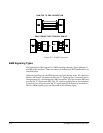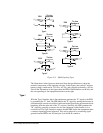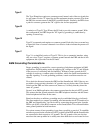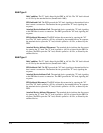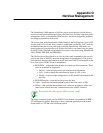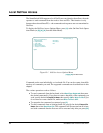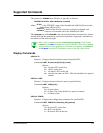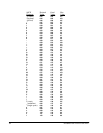
Appendix D
NetView Management
The SmartSwitch 1800 supports a NetView service point function, which allows a
node to be configured and managed from a NetView host. NetView support provides
management access to downstream SDLC devices, and allows diagnosing problems
and changing parameters in the node.
The service point in the SmartSwitch 1800 connects to the NetView host via an LLC2
session (over LAN or frame relay), which is established at node IPL. LLC2 must be
installed in either the service point node or another SmartSwitch 1800 that is con-
nected to the service point node via X.25 (physical link or over frame relay per Annex
G or RFC 1490). (The link can be between two nodes of any type among SmartSwitch
1800, 9W004, FRX4000, and FRX6000.)
The NetView host (also referred to as a focal point) sends commands to the service
point in the form of NMVTs (network management vector transports). The service
point function translates information from the node into NMVTs and responds to the
host. Four types of NMVTs can be transmitted:
●
RUNCMDs – commands from the host to execute specified operations. Three
types of command are supported:
◆
Display – used to display status and configuration information
◆
Vary – used to change the active/inactive status of a PU or line.
◆
Modify – used to change configuration of a PU and the line between it and
the node.
●
RUNCMD replies – from the service point to the host.
●
Alerts – unsolicited information about events in the node, lines, or PUs.
●
LPDAs – link problem determination aids, which are procedures used to test
status and to control the node, communications line, and PU interface.
The SmartSwitch 1800 supports LPDA versions 1 and 2.
The actual command syntax used in NMVTs from the host is documented in IBM’s
VTAM Operation manual. Responses to host commands generally use the textual
characteristics of VTAM (with a different prefix).




